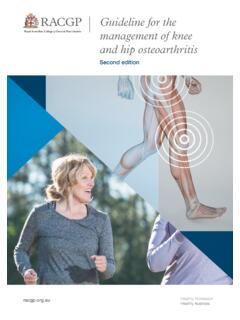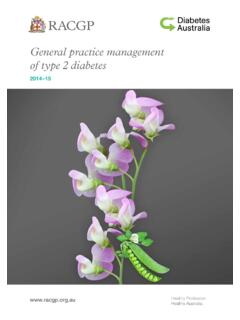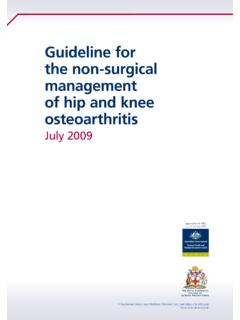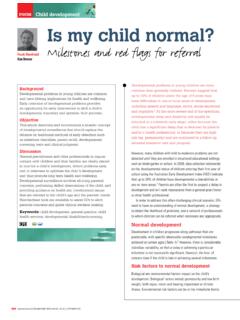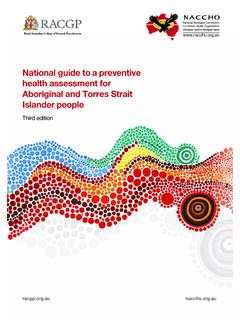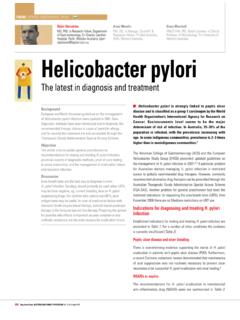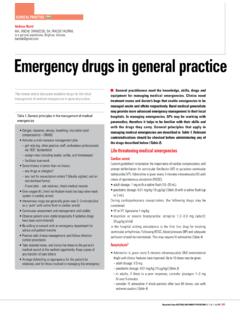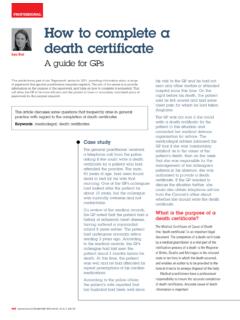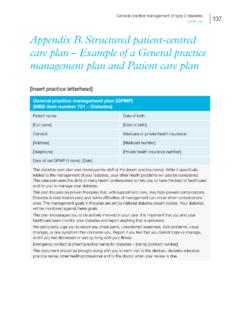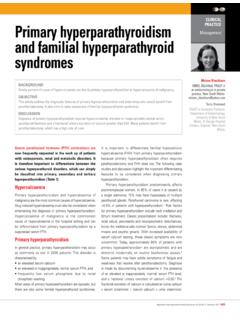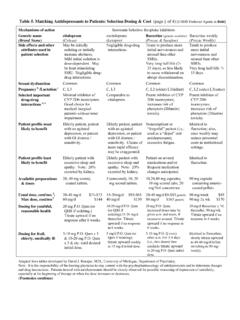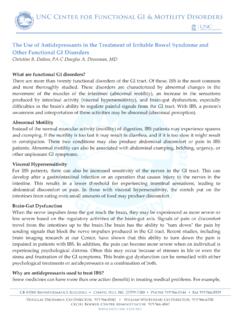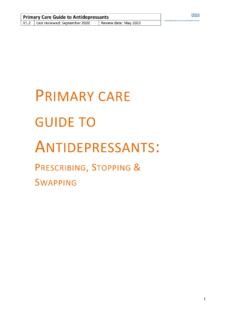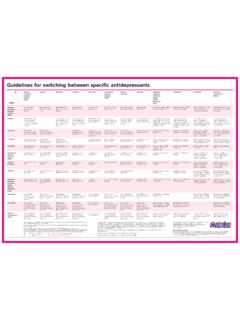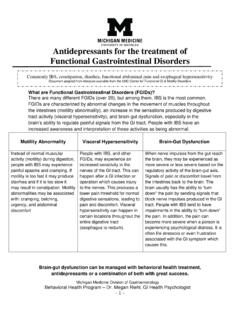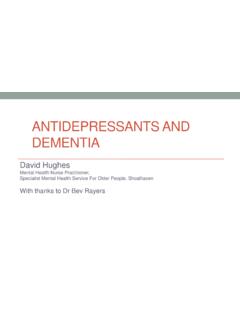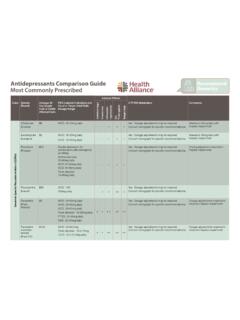Transcription of clinical Combination antidepressants - RACGP
1 ClinicalBackgroundCurrent treatment of depression fails to achieve remission in 50% of patients. Combinations of two antidepressants are used by some Australian psychiatrists. Objective This article investigates the pros and cons of Combination antidepressant therapy and provides suggestions for when to consider their use, which combinations to choose, and how to introduce Combination antidepressant two antidepressants is a controversial strategy, with supporters and critics arguing its efficacy and safety from opposing perspectives. The use of Combination antidepressant therapies may facilitate remission from depression. However, there is limited evidence supporting these treatments, and safety concerns are of ten cited. There is some support for Combination therapies in selected cases from international bodies. Af ter considering risks and benefits on a case-by-case basis, careful use of selected Combination antidepressant therapy may be one of a range of effective treatments for some individuals suffering from depression.
2 Keywords: depression; Combination antidepressantsDavid HorganSeetal DoddFor 50% of sufferers, depression is a lifelong illness. A 23 year follow up of first episode depression showed the illness to be unremitting in 15% of patients, and recurrent in 35%.1 Analogous to cancer, failure to achieve total eradication of depressive illness (remission) by vigorous treatment worsens the prognosis regarding recovery and relapse. Despite government initiatives in recent years, many doctors still report to the authors a lack of easy access to psychiatrists for advanced pharmacological management of depression, increasing the burden on general practitioners. This article aims to examine the evidence regarding Combination antidepressants , and discusses practical aspects of their use in the minority of patients who may benefit from this and international views A number of guidelines have been published since 2008, summarising psychiatric practice in various countries.
3 In the United Kingdom, the 2009 National Institute for Health and clinical Excellence (NICE) National clinical Practice Guideline 90 stated that combining antidepressant drugs with different modes of action is increasingly used in clinical practice ;2 and the 2009 Maudsley Prescribing Guidelines describe a selective serotonin reuptake inhibitor (SSRI) or venlafaxine combined with mirtazepine or mianserin for refractory depression as options among the commonly used treatments generally well supported by published literature .3 In Canada, the 2009 Canadian Network for Mood and Anxiety Treatments (CANMAT) guidelines state (with respect to Combination antidepressants ) the best available evidence is for add on treatment with mirtazapine/mianserin, or bupropion , and state there is level 2 evidence for these The 2010 depression treatment guidelines of the American Psychiatric Association state that, for refractory depression, the addition of a second non-MAOI [monoamine oxidase inhibitors] antidepressant may be helpful, particularly for patients who have had a partial response to antidepressant monotherapy.
4 5 The Australian Therapeutic Guidelines: Psychotropic (2008) take a different position, stating there is little evidence supporting the use of combined antidepressants in treatment resistant depression, and there are significant concerns regarding the potential for serious drug interactions .6 Combination antidepressants Use by GPs and psychiatristsReprinted from AUSTRAlIAN FAMIly PHySICIAN VOl. 40, NO. 6, JUNE 2011 397 Combination antidepressants use by GPs and psychiatristsclinicalA 2004 survey sent to all Australian consultants and nonconsultants in psychiatry (with a 33% response rate) showed that 76% of respondents (including 79% of consultant psychiatrists) had already used Combination Some Australian authors have argued that, due to a paucity of evidence, Combination antidepressant therapies should only be used as a last resort in specialist is the evidence base?
5 The only published, well funded trial of Combination antidepressants has been as a treatment arm involving 565 patients as part of the STAR*D In this study, in part funded by the United States of America National Institute of Health, no additional safety precautions were considered necessary for the combinations used in this trial, being citalopram with the addition of sustained release bupropion (not available on the Pharmaceutical Benefits Scheme [PBS] in Australia for the treatment of depression), and at another level in the trial being venlafaxine combined with and medium sized trials, and multiple case reports, suggest there are benefits from Combination In a meta-analysis of 27 trials involving 667 patients failing to respond adequately to monotherapy, lam et al11 reported a 62% response rate from Combination antidepressants .
6 This result must be tempered by the very small number of randomised controlled trials and the large number of small case series included in this meta-analysis. Carpenter et al12 reported a double blind placebo controlled trial of adjunctive mirtazapine or placebo after failure to respond to antidepressant monotherapy in depressed patients (N=26), showing that 64% of Combination antidepressant treated patients responded, including achieving remission, whereas only 20% of monotherapy treated patients responded and achieved combining antidepressants with switching antidepressants , half of the 61 patients who failed to respond to two monotherapy trials were given a third monotherapy of citalopram or bupropion, while the other half took combined citalopram and bupropion. Remission was four times more common in the Combination antidepressant group than in the switched antidepressant group, with no significant difference in side effect burden when compared to double blind study of 61 patients showed significant benefit when paroxetine was combined with mirtazapine, compared with monotherapy with either medication alone.
7 Nonresponders to either antidepressant did significantly better when the other antidepressant was In a recent study, 105 patients were randomly assigned over 6 weeks to fluoxetine alone (25% achieved remission), or to three different combinations of antidepressants , achieving 52% remission for mirtazapine plus fluoxetine, 58% remission for mirtazapine plus venlafaxine, and 46% remission for mirtazapine plus bupropion. Furthermore, double blind withdrawal of one component of the Combination over 6 months produced a relapse in 40% of In the same journal, examination of the findings raised issues such as the low dose of fluoxetine used and the 6 week duration of the trial. The results were seen as mainly supporting the addition of mirtazapine to reuptake search of clinical trial registries shows that many further trials are underway or recently completed, including a National Institute of Health funded trial of combinations of bupropion, escitalopram, mirtazapine, and venlafaxine ( Identifier: NCT00590863).
8 When to combine antidepressantsBefore considering treatment for depression it is necessary to first consider and exclude any factors which may prevent remission, including accurate diagnosis, comorbitities, psychosocial factors and treatment Psychological therapies should also be considered as a first line treatment or as an add-on to the evidence base for antidepressant monotherapy as a first line treatment for depression is strong, the evidence base for second line treatments when remission is not achieved is not as strong. Before considering Combination antidepressants , numerous alternative therapies can be chosen, including antidepressant dose escalation, or switching to another antidepressant monotherapy. It is generally agreed that the addition of lithium or of atypical antipsychotics are effective treatment strategies for depression that has partially responded to an antidepressant .
9 However, many of these options also have limited evidence bases, limited efficacy or their own safety concerns. Where such strategies have failed, or are not feasible financially, Combination antidepressants may represent an effective next step. Initiating a nonpharmacological (psychological) therapy may be useful and is supported by both sides of this controversy. In Australia, Combination antidepressants are used more commonly as a later treatment option, especially for partial responders to monotherapy. Blier et al15 point out that half of all patients discontinue antidepressant treatment within 6 weeks from initiating treatment, highlighting the importance of initiating treatment with effective medications, or moving rapidly to consolidate and hopefully add to initial, but limited, treatment gains. How to combine antidepressantsIn the absence of robust large trials in this area, Table 1 represents the experience and specialist discussions of one author (DH), who has used Combination antidepressants in selected patients over a 20 year period.
10 The second antidepressant should ideally have a complementary biochemical mechanism of action and acceptable side effects, such as adding reboxetine or mirtazapine to an SSRI. Ongoing titration of antidepressants to the patient s symptoms is very useful in achieving compliance and remission. Patients can be advised to contact their doctor if there is symptom recurrence, such as when faced with extra stress, after a virus, or premenstrually, or if symptoms of overmedication appear, such as the yES syndrome (yawning, Expression/word finding difficulty, Silly mistakes).17 The effects of dose change are usually evident within 2 3 days (based on the author s clinical experience with many patients). As the use of combined antidepressants remains controversial in Australia, and is outside manufacturers guidelines, it is appropriate to notate that you have discussed this issue with the patient, and ideally with a psychiatrist, if this can be arranged.
